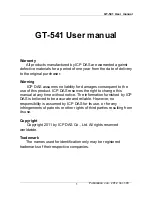
Using the Web Configuration Interface
802.11 User classification
66
VLAN priority 1 maps to 802.11 priority 1. You can change this mapping by clicking Enable
and changing the values in the 802.11 Priority column. When you are finished, click
Change
.
802.11 User classification
From the Link page, click
User Classification
.
User classification provides a means of classifying or dropping frames. Classification
provides privileges to higher priority frames, which are sent before lower priority frames.
User Classification is only available for the 802.11 interface (eth1).
The user classification page provides a way for users to construct a tree of rules, known as
a decision tree. The goal is for each frame to migrate through the decision tree. Eventually,
a frame gets to a rule indicating a classification, dropped, or no action. The decision tree is
presented as a table where each row has an index value. The first row is 0, and so on.
Each rule identifies a field in the frame, an operator, one or more values, a true rule index,
and a false rule index. The operator identifies how to compare the field in the frame against
the value(s).
The fields that are applicable to the rules are:
•
SRC/DST MAC Address
•
Ethernet II Ether Type
•
IP Protocol
•
TCP and UDP source ports
•
TCP and UDP destination ports
•
802.1 P/Q priority
PQ mapping is applied to frames before User Classification rules are applied. The Priority
field refers to the frame’s current priority. If the frame has already been classified, the
















































